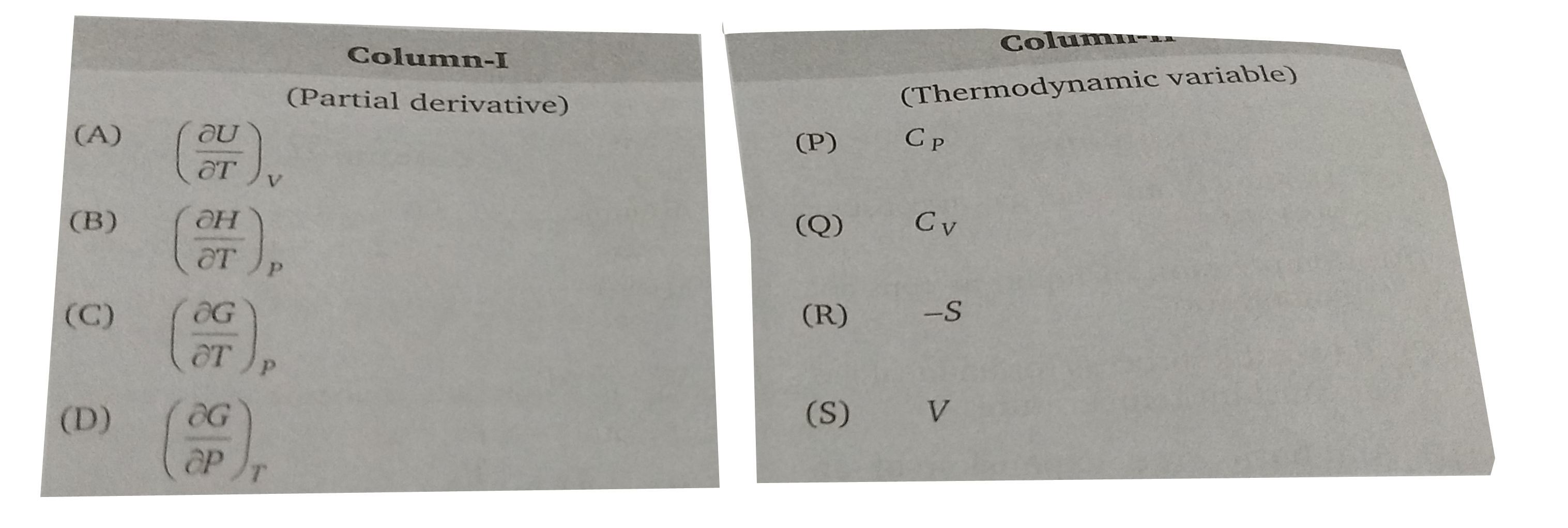Determine which of the following reactions at constant pressure represent surrounding that do work on the system environment :
(P) 4NH3(g)+7O2(g)→4NO2+6H2O(g)
(Q) CO.O(g)+2H2(g)→CH3OH(l)
(R) C(s,graphite)+H2O(g)→CO(g)+H2(g)
(S) H2O(s)→H2O(l)Solution in Punjabi
III, IV
II and III
II, IV
I and II, IV
The correct Answer is:D
w=−Pext.ΔV=−ΔngRT and Δng is -ve for I and III
also ΔV=−ve for IV
Topper's Solved these Questions
- BOOK - NARENDRA AWASTHICHAPTER - THERMODYNAMICSEXERCISE - Level 3 - One Or More Answers Are Correct1videos
THERMODYNAMICS
- BOOK - NARENDRA AWASTHICHAPTER - THERMODYNAMICSEXERCISE - Level 3 - Match The Column2videos
THERMODYNAMICS
- BOOK - NARENDRA AWASTHICHAPTER - THERMODYNAMICSEXERCISE - Level 2 (Q.1 To Q.30)1videos
THERMODYNAMICS
- BOOK - NARENDRA AWASTHICHAPTER - STOICHIOMETRYEXERCISE - Level 3 - Subjective Problems20videos
STOICHIOMETRY
Similar Questions
Assume ideal gas behaviour for all the gases considered and neglect vibrational degrees of freedom. Separate equimolar sample. Separate equimolar samples of Ne, O2 , CO2 and SO2 were subjected to a two process as mentioned. Initially all are at same state of temperature and pressue.
Step I → All undergo reversible adiabatic expansion to attain same final volume, which is double the original volume thereby causing the decreases in their temperature.
Step → After step I all are given appropriate amount of heat isochorically to restore the original temperature.
Mark the correct option(s) :04:57View SolutionMatch the following columns
 View Solution
View SolutionWrite structure of 2,2-dimethylheptane.
01:03View SolutionWhat volume of a liquid (in L) will contain 10 mole ? If molar mass of liquid is 280 and its density is 1.4 g/mL.
03:26View SolutionDetermine which of the following reactions at constant pressure represent surrounding that do work on the system environment : (P) 4NH_(3)(g) + 7O_(2)(g) to 4 NO_(2)+ 6H_(2)O(g) (Q) CO.O(g)+ 2H_(2)(g) to CH_(3)OH(l) (R) C("s,graphite")+H_(2)O(g) to CO(g)+H_(2)(g) (S) H_(2)O(s) to H_(2)O(l)
01:57View SolutionFor which reacrion (s) is the ΔH value close to the ΔE value ?
(p)CH4(g)+2O(g)→CO(g)+2H2O(l)
(Q)C2H4(g)+3O2(g)→2CO2(g)+2H2O(g)07:50View SolutionFor the following reactions (1) , (2) and (3) equilibrium constants are given (1) CO_(2)(g) +H_(2)O(g) hArr CO_(2)(g) +H_(2)(g), K_(1) (2) CH_(4)(g) +H_(2)O(g) hArr CO(g)+3H_(2)(g),K_(2) (3) CH_(4)(g)+2H_(2)O(g) hArr CO_(2)(g)+4H_(2)(g), K_(3) Which of the following relation is correct ?
01:30View SolutionDetermine which of the following reactions at constant pressure represents surroundings that do work on the system:
I. 4NH3(g)+7O2(g)→4NO2(g)+6H2O(g)
II. CO(g)+2H2(g)→CH3OH(l)
III. C(s,graphite)+H2O(g)→CO(g)+H2(g)
IV. H2O→H2O(l)02:41View SolutionWrite the equilibrium constant of the reaction
C(s)+H2O(g)⇔CO(g)+H2(g)View Solutionनिम्नलिखित अपचयोपचय अभिक्रियाओं को वर्गीकृत कीजिए -
(क) N2(g)+O2(g)→2NO(g)
(ख) 2Pb(NO3)2(s)→2PbO(s)+4NO2(g)+O2(g)
(ग) NaH(s)+H2O(l)→NaOH(aq)+H2(g)
(घ) 2NO2(g)+2OH−(aq)→NO−2(aq)+NO−3(aq)+H2O(l)01:57View SolutionIn what manner will increase of pressure affect the following equilibrium ? C(s) + H_(2)O (g) hArr CO(g) + H_(2) O (g)
05:15View SolutionFor the reaction ,
2C2H6(g)+7O2(g)→4CO2(g)+6H2O(l), the rate of disappearnce of C2H6(g) :03:34View SolutionFrom the following data, C(s , graphite) + O_(2) (g) to CO_(2) (g) H_(2) (g) + (1)/(2) O_(2) (g) to H_(2) O (l) Delta H_("reaction")^(@) = -286 kJ/mole 2 C_(2) H_(6) (g) + 7O_(2) (g) to 4 CO_(2) (g) + 6H_(2) O (l) Delta H_("reaction")^(@) = -3120 kJ/mole Calculate the standard enthalpy of formation of C_(2) H_(6) (g) ( in kJ/mole)
03:56View SolutionCalculate H∘ for the reaction ,
Na2O(s)+SO3(g)→Na(2)SO4(g)
(A)Na(s)+H2O(l)→NaOh(s)+12H2(g)
ΔH∘)=−146kJ
(B) Na2SO4(s)+(H)2O(l)→2Na(s)+SO3(g)
ΔH∘=+418kJ
(C) 2Na2O(s)+2H2(g))→4Na(s)+2H2O(l)
ΔH∘=+259kJ03:49View SolutionIdentify the exothermic and endothermic changes:
(i) NO(g)+12O2(g)→NO2(g)+57.0kJ
(ii) H2O(s)+6.02kJ→H2O(l)
(iii) C(s)+H2O(g)→CO(g)+H2(g)−130kJ.07:00View SolutionHow can the yield of the product be increased by changing the volume of the reaction system in the given reactions at constant temperature?
(1) C(s)+H2O(g)⇔CO(g)+H2(g)
(2) 2H2(g)+O2(g)⇔2H2O(l)07:25View Solution

